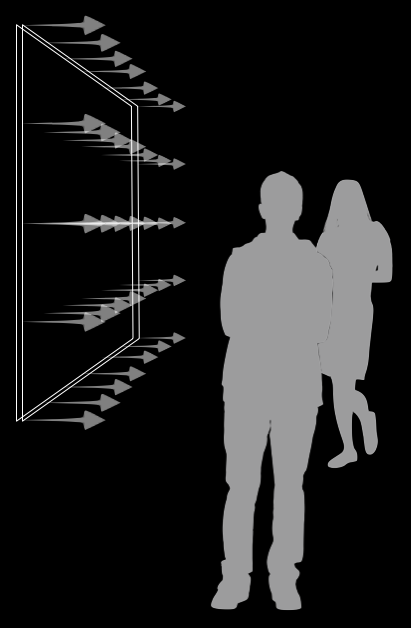Studies on Canvas
for a 6x5 grid of 30 flat-panel loudspeakers under canvas • June 2004, c.22' looped
CONCEPT • DOCUMENTATION |
|
|
CONCEPT
Studies on Canvas (2004) is the first installation in the GRIDs series. It comprises 30 flat-panel speakers in a 6x5 arrangement behind the blank canvas. Collectively, these present a series of studies which explore the notion of image. Normally associated with the visual, image refers to "a representation of the external form of a person or thing..." (OED), either physically or in the mind; in audio, image tends to be used to describe the distribution of sound presented over two or more loudspeakers — again a representation or fabrication, but of a space.

Studies on Canvas aims to reflect and explore both senses of the word. Viewers/listeners are presented with a blank canvas, which remains blank throughout the installation. Such images as may be perceived are rendered entirely in sound; any visual content of the canvas must be imagined. Unlike a painting, these images are animate, permitted to move around the canvas and occupy increasing and decreasing amounts of it; they are also transitory, not fixed permanently to the material upon which they are displayed. Like a painting, however, the images remain captured events, frozen at least in a space, if not time.
Studies on Canvas was commissioned by Sonic Arts Network for the Sound Circus conference, June 11-13 2004.
ASSOCIATED RESEARCH: TROMPE L'OREILLE
The notion of trompe l’oreille was influential in the conception of Studies on Canvas which, being an extensive exploration of visual/aural metaphor, relies heavily on referential material to present a convincing sonic ‘image’. Thus the listener is invited to ‘look’ into a churning mud-pool in bubbles or at a timber frenzy in wood, ‘watch’ marbles rolling around a bagatelle board and ‘gaze’ upon an (apparently) idyllic woodland ‘scene’ in during foot and mouth in Devon. While the ‘frame’ represented by the canvas clearly abstracts the material from its purported context, in many ways the idea was to transcend it altogether, creating a virtual window on the real, with sounds in their spatial and sonic behaviour being practically indistinguishable from reality – albeit a reality that verges on the surreal in places.
These concerns informed the development of the future Dome (2012) and Beyond (2014+) works which wrapped the 'canvas' over hemispherical and spherical structures respectively.